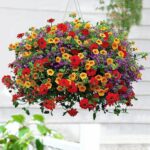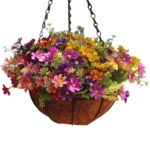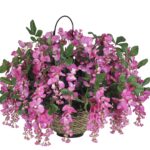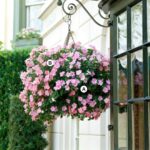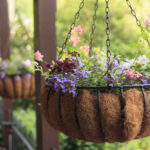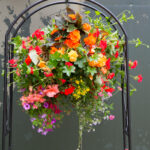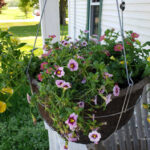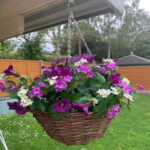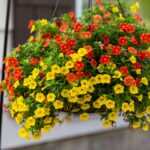Hanging flower baskets are a wonderful way to add vibrant colors and lush greenery to any space, be it a porch, balcony, patio, or garden. They offer an eye-catching display that can brighten up any area and provide a vertical gardening solution for those with limited space. Here’s a comprehensive guide to creating and maintaining beautiful hanging flower baskets.
1. Choosing the Right Basket
The first step in creating a stunning hanging flower basket is selecting the right container. Here are some options to consider:
- Wire Baskets: Often lined with coco coir or moss, wire baskets provide excellent drainage and a natural look.
- Plastic Baskets: Lightweight and usually equipped with a built-in water reservoir, these are practical and easy to maintain.
- Wooden Baskets: These add a rustic charm but may require additional lining to retain moisture.
Ensure the basket has adequate drainage holes to prevent waterlogging and root rot.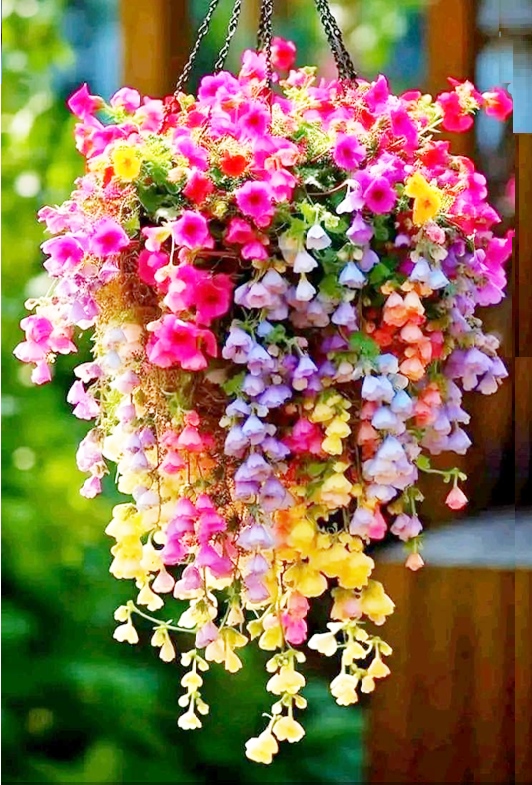
2. Selecting the Perfect Plants
Choosing the right plants is crucial for a successful hanging basket. Consider the following factors:
- Sunlight Requirements: Determine whether your basket will be in full sun, partial shade, or full shade and select plants accordingly. Petunias, geraniums, and verbena thrive in full sun, while fuchsias and impatiens prefer shade.
- Plant Compatibility: Choose plants with similar water and light needs. Combining trailing, filler, and thriller plants creates a balanced and visually appealing arrangement. Trailing plants like ivy, fillers like lobelia, and thrillers like fuchsia work well together.
3. Preparing the Basket
Once you have your basket and plants, it’s time to prepare for planting:
- Line the Basket: If using a wire or wooden basket, line it with coco coir, moss, or a specialized liner to retain soil and moisture.
- Add Potting Mix: Fill the basket with a high-quality potting mix, which is lightweight and provides good drainage. Mix in a slow-release fertilizer to ensure continuous feeding.
4. Planting Your Basket
When planting your hanging basket, consider the following steps:
- Start with Trailing Plants: Place trailing plants around the edge of the basket, allowing them to drape over the sides.
- Add Fillers: Plant fillers in the center of the basket, providing fullness and color.
- Incorporate Thrillers: Finally, place a few taller plants in the middle for height and drama.
Ensure the plants are spaced adequately to allow for growth and provide a balanced look.
5. Caring for Your Hanging Basket
Maintaining your hanging basket is key to keeping it vibrant and healthy:
- Watering: Hanging baskets dry out quickly, especially in full sun. Water them thoroughly until water drains out of the bottom. In hot weather, they may require daily watering.
- Fertilizing: Feed your plants with a liquid fertilizer every 2-4 weeks to promote blooming and growth.
- Pruning: Regularly deadhead spent flowers and trim back any leggy growth to encourage new blooms and maintain a tidy appearance.
- Pest Control: Monitor for pests like aphids and spider mites. Treat infestations promptly with insecticidal soap or neem oil.
6. Seasonal Tips
To keep your hanging baskets looking their best throughout the seasons, consider these tips:
- Spring: Start with cool-season plants like pansies and violas. As the weather warms, transition to summer-blooming plants.
- Summer: Ensure regular watering and fertilizing. Deadhead frequently to keep plants blooming.
- Fall: Replace summer plants with fall-friendly options like mums and ornamental kale.
- Winter: In mild climates, consider evergreen plants or winter-flowering varieties like pansies. In colder regions, protect baskets from frost or bring them indoors.
 Flower Love
Flower Love

